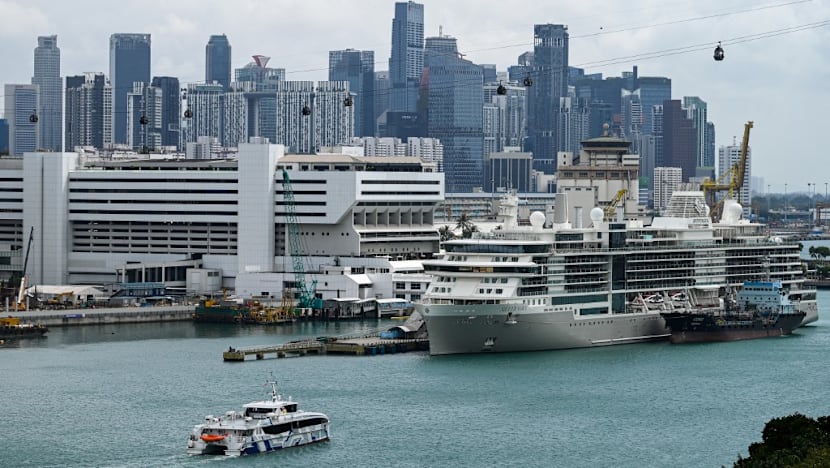Cruise boom keeps Singapore's marine and port services busy
Cruise passenger throughput has recovered to pre-pandemic levels, reaching 1.85 million last year, according to the Singapore Department of Statistics.

A cruise ship docked at Harbourfront Terminal in Singapore on Feb 25, 2025. (Photo: AFP/Roslan Rahman)

This audio is generated by an AI tool.
SINGAPORE: Behind the glitz and glamour of cruise getaways lies a world of intensive maintenance and upkeep that ensures these massive holiday vessels remain seaworthy.
With a surge in Singapore’s cruise scene, local companies offering ancillary services are being kept busy. These behind-the-scenes firms deal with ship upgrades and repairs, restocking and refuelling, waste management, implementing measures to reduce the sector’s environmental footprint, and more.
Marine interior refurbishment firm ICF Group said business has risen by nearly 30 per cent from last year, thanks to more cruise ships docking in Singapore. In the first quarter this year, the firm delivered nine cruise refurbishments within three months.
“We’re seeing more (projects) coming,” said its CEO Annie Chua, adding that the company’s order book for the first half of next year is already full with dry docking work.
The business is finding smarter and faster ways to cope with the extra workload.
“We are upscaling with training capability … leveraging on artificial digital tools (and) investing in additional hardware and software to speed up some of our processes,” Ms Chua said.
It uses 3D scanning to create detailed digital models of vessel interiors, allowing designers and engineers to plan upgrades more accurately.
Parts are also built in advance so that when ships arrive, they can be fitted quickly – cutting down the time vessels need to stay in port. More than 70 per cent of ICF Group’s products are now prefabricated in its workshop.
The company is also nurturing new talent through mentorship programmes and partnerships with local polytechnics.
GREENER SHIPS, GREATER EFFICIENCY
At shipbuilding company Seatrium, the number of projects has grown by about 20 per cent from last year.
As cruise ships become bigger and greener, the company – which employs about 24,000 workers – is evolving to provide energy-efficient solutions.
Its executive vice president of repairs and upgrades Alvin Gan said the firm focuses on greening areas such as hull lubrication systems, paint coatings and engine efficiency.
Alternative fuels are also a major push for sustainability in the sector. Seatrium is studying the use of biofuels such as methanol, as well as hydrogen fuel cell systems and green ammonia.
“Shipping is going through the energy transition phase. There are many (such) projects right now (and) will continue to increase in the near future. It’s very exciting in terms of the decarbonisation space,” said Mr Gan.
ECONOMIC IMPACT AND CONNECTIVITY
According to the Singapore Tourism Board (STB), Singapore's cruise industry last year contributed S$1.4 billion (US$1.08 billion) in economic output and more than S$500 million in gross domestic product (GDP), while creating over 7,500 jobs.
The statutory board’s assistant chief executive Jean Ng said Singapore adds value to cruise lines in three broad areas – strong infrastructure, attractive destination and customer experience.
She said the nation’s status as an aviation hub, with flight connections to about 160 cities, offers passengers the flexibility to fly in or out conveniently, making it an ideal gateway for cruises.
Singapore’s maritime and port services also deliver a wide range of reliable maintenance and technical support, ensuring cruise ships are well-serviced, safely operated and able to turn around efficiently between voyages.
Ms Ng added that the nation’s location along major cruising sea lanes makes it an ideal refuelling stop, supported by ongoing efforts to ensure efficient turnarounds.
She said the STB has been working with the Immigration & Checkpoints Authority (ICA) to enable faster customs clearance, such as through automated lanes for passengers, and allowing cruise ships to submit their manifests electronically.
“These services really add to the customer experience, and that's what gives us an edge in enticing cruise lines to be hubbing through Singapore,” said Ms Ng.
REGIONAL APPROACH TO GROWTH
Beyond Singapore, STB is working with neighbouring countries to enhance the appeal of regional destinations.
The goal is to position Southeast Asian cities as key ports of call and attract more cruise ships to the region, which will in turn grow the industry and support related services.
One major challenge in the region, however, is that many ports lack the infrastructure to accommodate the growing size of cruise ships.
“What we try to do is to inform them of the cruise lines' requirements, the types of ships that they may deploy to (our) region. That (could) help them upgrade their port infrastructure to also capture a part of this demand,” she said.
MARINA BAY CRUISE CENTRE
The reopening of the Marina Bay Cruise Centre on Wednesday (Oct 29) allows Singapore to handle the growing demand for bigger, more advanced vessels.
Among the upgrades following a S$40 million facelift are early baggage check-ins, which take less than half the time compared with before, and an additional check-in hall.
New shuttle services will also ferry tourists to popular attractions such as Gardens by the Bay, Chinatown and Marina Bay Sands.
The upgraded terminal can now hold 11,700 passengers – nearly double its previous capacity of about 6,700.
SATS-Creuers Cruise Services (SCCS), which operates the terminal, said the reopening marks another step in cementing Singapore’s position as a leading cruise hub.
“We’re setting the pace of cruising in Asia. The new facilities allow us to serve more passengers more efficiently with greater comfort and better connectivity. They prepare us for the mega ships of tomorrow and the demands of the growing region,” said the organisation's CEO Gregory Tan.
“Our journey does not stop here. SCCS will continue to make enhancements for future cruising, exploring new ways to raise efficiency and passenger experience through innovation and technology.”

















